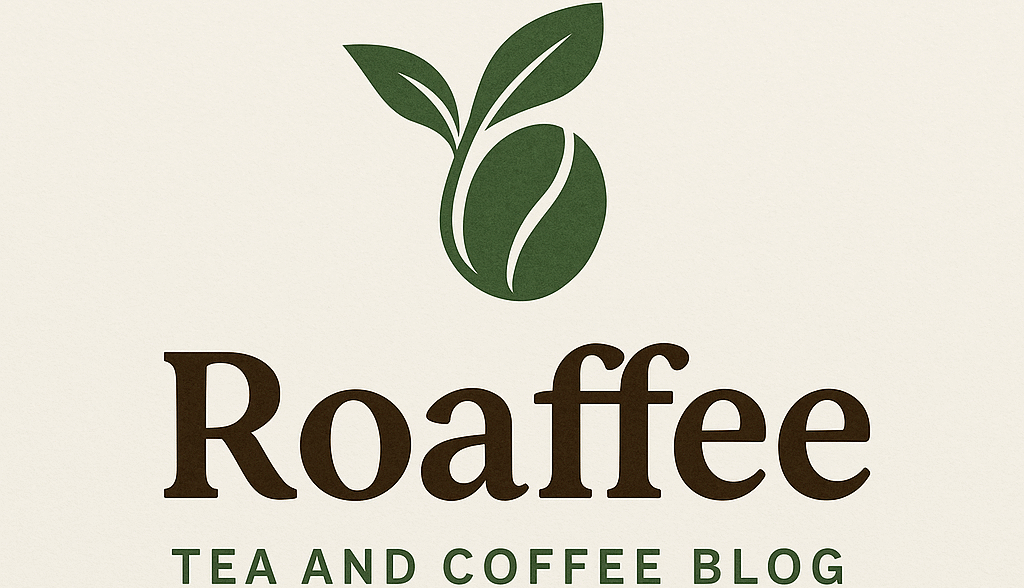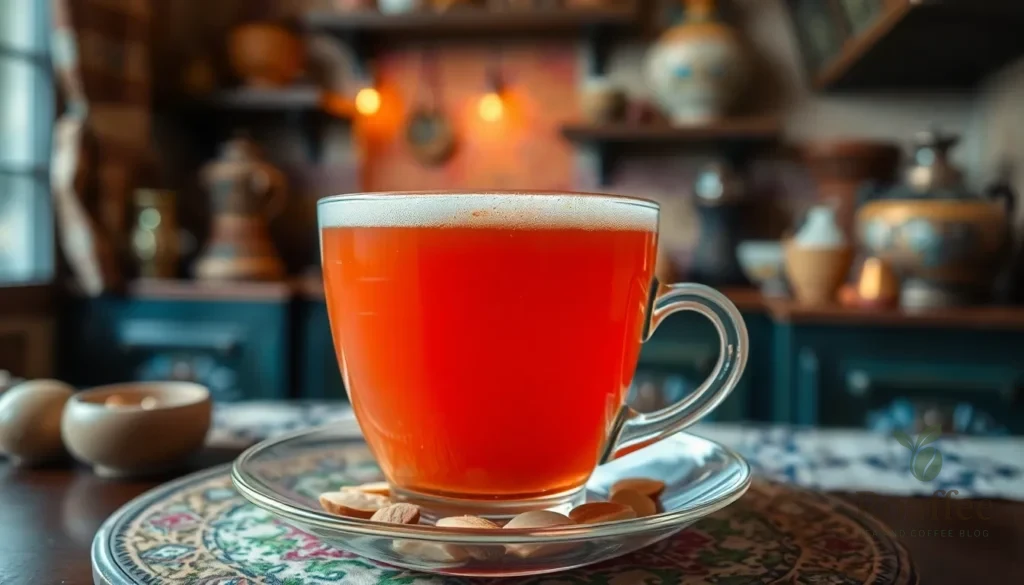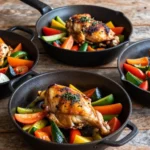We’re about to take you on a sensory journey to the breathtaking valleys of Kashmir with this authentic Kashmiri tea recipe. This isn’t your ordinary cup of tea – it’s a pink-hued masterpiece that’s been warming hearts and homes across the Himalayan region for centuries. Also known as “noon chai” or “sheer chai,” this traditional beverage transforms simple ingredients into something truly magical.
What sets Kashmiri tea apart is its distinctive salmon-pink color and rich, creamy texture that comes from a unique brewing process. The secret lies in the special technique of aerating the tea, which creates that signature frothy appearance and develops the complex flavors that make this drink so beloved.
We’ll walk you through every step of creating this authentic delicacy in your own kitchen. From selecting the right tea leaves to mastering the traditional churning method, you’ll discover how to recreate this Himalayan treasure that’s perfect for cold mornings or cozy evenings with loved ones.
What Is Kashmiri Tea
Kashmiri tea stands as one of the most distinctive beverages in South Asian cuisine. We know this traditional drink by several names including noon chai, sheer chai, or pink tea. The beverage originates from the Kashmir region and has been a cultural staple for centuries.
The tea’s signature salmon pink color comes from a unique brewing process that involves special alkaline ingredients. We achieve this vibrant hue through the careful combination of green tea leaves, baking soda, and salt during the initial brewing stage. The alkaline environment creates a chemical reaction that transforms the tea’s natural color.
Kashmiri tea differs significantly from regular chai in both preparation and taste profile. We use green tea leaves instead of black tea as the base ingredient. The brewing process requires extensive churning or ladling between vessels to create the characteristic frothy texture and develop the pink color.
The flavor profile combines creamy richness with subtle saltiness. We traditionally serve this tea with crushed almonds, pistachios, or cardamom for added complexity. The drink has a smooth, velvety texture that coats the palate without being overly sweet.
This ceremonial beverage plays an important role in Kashmiri hospitality and social gatherings. We often prepare large quantities for special occasions, weddings, and religious festivals. The tea brewing process itself becomes a communal activity that brings families and communities together.
The nutritional aspects of Kashmiri tea include antioxidants from green tea leaves and healthy fats from nuts and milk. We consider this beverage both nourishing and warming, making it perfect for cold mountain climates where it originated.
Ingredients

Creating authentic Kashmiri tea requires exact ingredients that work together to achieve the signature pink color and creamy texture. We’ve organized these ingredients into two categories to help you prepare this traditional beverage with confidence.
For the Tea Base
- Kashmiri green tea leaves: 3-6 tablespoons (special Kashmiri or Chinese green tea, not typical chai leaves)
- Water: 4-8 cups (cold water to start)
- Baking soda: ¼ to 1 teaspoon (essential for the pink color development)
- Salt: ¼ to ½ teaspoon (traditionally salty, though sugar can be substituted)
- Cardamom pods: 4-6 pods, slightly crushed
- Whole spices (optional but recommended):
- Cinnamon stick: 1 small piece
- Star anise: 1 pod
- Cloves: 3 pieces
- Nutmeg: pinch (optional)
- Saffron: pinch (optional)
For the Garnish
- Milk: 1-2 cups (full cream milk for optimal creamy texture)
- Chopped pistachios: for royal garnish
- Chopped almonds: for traditional presentation
- Sugar: optional, if preferred sweet instead of the traditional salty profile
Equipment Needed

Creating authentic Kashmiri tea requires exact kitchen tools that help achieve the signature pink color and frothy texture this beloved beverage is known for. We recommend gathering these essential items before beginning our brewing process to ensure smooth preparation from start to finish.
Essential Cooking Equipment:
- Medium saucepan or pot – A heavy-bottomed vessel works best for even heat distribution during the extended simmering process
- Ladle – Critical for the traditional stirring and pouring technique that develops the tea’s characteristic color
- Fine-mesh strainer – Necessary for filtering out tea leaves and whole spices before serving
- Measuring cups and spoons – Precision matters when balancing the salt, baking soda, and other ingredients
Specialized Tools for Authentic Preparation:
- Second container or bowl – Essential for the aeration process where we pour the tea back and forth from height
- Whisk or traditional churning tool – Helps create the frothy texture that makes Kashmiri tea distinctive
- Serving cups – Traditional small glasses or cups that showcase the beautiful pink hue
Additional Helpful Items:
- Mortar and pestle – Useful for crushing cardamom pods and other whole spices to release maximum flavor
- Small bowls – Perfect for organizing crushed nuts and spices before garnishing
The ladle serves dual purposes in our preparation method. We use it not only for stirring during the simmering phase but also for the crucial aeration step that transforms ordinary green tea into the signature pink-colored beverage. The height from which we pour the tea between containers directly impacts the final color development and texture.
Our medium saucepan should accommodate the initial water volume plus room for the vigorous stirring required during the 10-15 minute simmering process. The fine-mesh strainer ensures our final cup remains smooth and free from any tea leaves or spice particles that could interfere with the creamy drinking experience.
Instructions

Follow these step-by-step instructions to create authentic Kashmiri tea with its signature pink color and creamy texture. We’ll guide you through each stage of the traditional brewing process.
Prep the Tea Base
Start by filling your medium saucepan with cold water directly from the refrigerator. Add the Kashmiri green tea leaves to the cold water along with your selected spices including star anise, cinnamon stick, cloves, and green cardamom pods. Place the saucepan on high heat and bring the mixture to a rolling boil. The cold water helps extract maximum flavor from the tea leaves during the heating process.
Boil and Simmer
Once the water reaches a boil, add a pinch of baking soda to the mixture. This crucial ingredient reacts with the tea leaves and begins the transformation that creates the signature pink or reddish color. Reduce the heat to medium and allow the tea to simmer for approximately 30 minutes, stirring occasionally with your ladle. Watch as the liquid reduces to about 2 cups during this simmering process. Add ice-cold water with ice cubes, pouring from a height to aerate the tea properly. Continue aerating by pouring the tea back and forth between your saucepan and second container for around 10 minutes to develop the distinctive color and enhance the flavor profile.
Add Milk and Spices
Bring the full cream milk to a boil in a separate saucepan while maintaining medium heat. Add sugar to the hot milk according to your taste preference, then pour in the prepared pink tea concentrate. Adjust the amount of concentrate based on how strong and pink you want your final tea to appear. Bring the milk and tea mixture to a gentle boil, then immediately turn off the heat and cover the saucepan for 2 to 3 minutes. This resting period allows all the flavors to infuse completely throughout the beverage.
Final Touches
Strain the finished tea through your fine-mesh strainer into individual serving cups or glasses. Garnish each cup with finely sliced pistachios and almonds for the traditional presentation. The tea should display a beautiful creamy pink color with a rich, frothy texture. Serve immediately while hot to enjoy the full flavor and aroma of this authentic Kashmiri beverage.
Directions for Perfect Color

Achieving the signature pink hue in Kashmiri tea requires precise timing and technique. We start with cold water directly from the refrigerator because temperature plays a crucial role in the color development process. The chemical reaction between the tea leaves and baking soda works best when we begin with chilled water.
The Baking Soda Reaction
We add baking soda to the boiling tea mixture as the key catalyst for the pink transformation. This creates an alkaline environment that reacts with the tannins in the Kashmiri green tea leaves. The reaction produces the distinctive salmon-pink color that makes this tea so visually striking.
The Reduction Process
After adding baking soda, we continue boiling the mixture until it reduces to approximately 2 cups of concentrated tea. This reduction intensifies both the color and flavor while creating the foundation for our perfect pink tea. The concentrated mixture should develop a deep amber tone during this stage.
Ice Water Addition Technique
Once we achieve the proper reduction, we slowly add ice-cold water back to the concentrate. Pouring from a height creates the first stage of aeration that helps develop the color further. The temperature contrast between the hot concentrate and cold water triggers additional color development.
The Aeration Method
We create the final pink color through extensive aeration by pouring the tea back and forth between containers for approximately 10 minutes. This churning process incorporates air into the mixture while continuing the chemical reactions that deepen the pink hue. The tea should develop a frothy consistency and reach its full pink potential during this stage.
Color Development Timeline
| Stage | Duration | Color Result |
|---|---|---|
| Initial boiling | 5-8 minutes | Light amber |
| Baking soda reaction | 2-3 minutes | Darker amber |
| Reduction phase | 10-15 minutes | Deep amber |
| Ice water addition | 1-2 minutes | Pink emergence |
| Aeration process | 10 minutes | Full pink color |
Final Color Enhancement
When we add the milk to our pink tea concentrate, the color becomes more pronounced and creamy. The proteins in the milk interact with the tea compounds to create the final beautiful pink shade that defines authentic Kashmiri tea. Salt addition at this stage helps maintain the color stability and enhances the overall appearance.
Serving Suggestions

We recommend serving Kashmiri tea hot to fully experience its warming properties and aromatic spices. The traditional presentation involves pouring the tea into small glasses or cups immediately after preparation to preserve the temperature and frothy texture.
Our serving approach focuses on garnishing each cup with finely sliced pistachios and almonds for authentic presentation. These nuts add textural contrast and enhance the visual appeal of the pink tea. We suggest slicing the nuts thinly rather than chopping them coarsely to distribute flavor evenly throughout each sip.
Temperature timing plays a crucial role in serving quality Kashmiri tea. We serve the tea within 5 minutes of final preparation to maintain optimal warmth and preserve the delicate foam layer. The pink color appears most vibrant when the tea remains hot.
| Serving Element | Recommendation | Purpose |
|---|---|---|
| Temperature | Hot (160-180°F) | Preserves aroma and flavor |
| Garnish | Sliced pistachios and almonds | Adds texture and visual appeal |
| Serving size | 6-8 oz per cup | Traditional portion |
| Timing | Within 5 minutes | Maintains foam and temperature |
We pair Kashmiri tea with traditional Indian snacks or sweets for complete cultural authenticity. The slightly salty and nutty flavor profile complements both savory and sweet accompaniments. Popular pairings include naan bread, kulcha, or traditional Kashmiri pastries.
Seasonal serving considerations enhance the tea experience significantly. We recommend serving Kashmiri tea during cold weather or after meals when its warming spices provide maximum comfort. The tea serves as an ideal beverage for evening gatherings or special occasions.
Customization options allow us to adjust the tea according to individual preferences. We modify the salt content for those preferring less salinity while maintaining the traditional flavor balance. Sugar additions work well for those seeking sweetness, though we add it sparingly to preserve the authentic taste.
Saffron strands create an optional enhancement for special occasions. We add a few strands to each cup for extra aroma and deeper color intensity. This addition transforms the tea into a more luxurious presentation suitable for guests or celebrations.
Storage Tips

Proper storage methods ensure we can enjoy our Kashmiri tea concentrate for multiple servings while maintaining its signature pink color and authentic flavor profile. The tea concentrate offers excellent storage flexibility when we separate it from the milk component.
Tea Concentrate Storage
We recommend storing the strained pink tea concentrate in an airtight container in the refrigerator for up to 2-3 days. The concentrate maintains its vibrant color and concentrated spice flavors during this period. Before using stored concentrate, we gently reheat it without bringing it to a vigorous boil to preserve the delicate pink hue.
Finished Tea Storage
Once we combine the concentrate with milk, the tea requires immediate consumption for optimal taste and texture. Fresh preparation delivers the best foam consistency and temperature experience. Refrigerated finished tea can last up to 24 hours, though we must reheat it with gentle stirring to restore its creamy consistency.
Garnish Storage Guidelines
We store pistachios and almonds in a cool, dry place to maintain their freshness and prevent rancidity. These nuts should remain separate from the tea preparation until serving time. Proper nut storage extends their shelf life and ensures they contribute the expected crunch and nutty flavor to each cup.
Spice Storage Considerations
Whole spices like cardamom pods, cinnamon sticks, and star anise maintain their potency longer than ground varieties. We store these aromatics in sealed containers away from direct sunlight and moisture. Fresh spices significantly impact the tea’s authentic flavor profile, making proper storage essential for consistent results.
Best Practices for Quality
Temperature control plays a crucial role in storage success. We avoid storing tea concentrate at room temperature for extended periods, as this can compromise both safety and flavor integrity. Glass containers work better than plastic for maintaining the tea’s distinctive taste without absorbing unwanted odors from the refrigerator.
Variations

While the classic Kashmiri tea recipe forms the foundation of this beloved beverage, many variations have emerged over centuries to suit different tastes and regional preferences. We explore both traditional and modern adaptations that showcase the versatility of this iconic pink tea.
Traditional Kashmiri Pink Tea
The authentic Kashmiri Pink Tea maintains its distinctive salty flavor profile that has warmed generations through harsh mountain winters. We prepare this traditional version using Kashmiri green tea leaves, water, baking soda, crushed cardamom, and salt as the core ingredients. The original recipe requires boiling the tea mixture for 45-60 minutes until the liquid reduces and deepens in color, creating the signature pink hue through the chemical reaction between baking soda and tea compounds.
Salt serves as the primary flavoring agent rather than sugar, providing essential minerals and energy needed during cold Kashmiri winters. We add icy cold water during preparation and stir vigorously to intensify the pink color before incorporating milk. The final step involves garnishing with crushed almonds or pistachios, creating a beverage that balances creamy richness with subtle saltiness.
Regional variations within Kashmir itself include adding whole spices like cinnamon or cloves during the initial boiling stage. Some families pass down recipes that incorporate exact ratios of salt to cardamom, creating unique flavor signatures that distinguish one household’s tea from another.
Modern Adaptations
Contemporary variations of Kashmiri tea cater to global palates while maintaining the essential pink color and creamy texture. We observe several popular modern interpretations that have gained popularity in cafes and homes worldwide.
Sweet Pink Chai represents the most common adaptation, where we add sugar or condensed milk instead of or alongside salt. This cafe-style version appeals to those accustomed to sweeter beverages while preserving the distinctive pink appearance and rich texture.
Dry Fruit Royal Pink Chai elevates the traditional recipe by incorporating abundant garnishes of almonds and pistachios. We prepare this luxurious version for special occasions, creating a richer experience that showcases the tea’s ability to complement various nuts and dried fruits.
International Adaptations reflect regional preferences across different countries:
| Region | Key Modifications | Flavor Profile |
|---|---|---|
| Afghan | Rose petals, increased cardamom | Sweeter, floral notes |
| Central Asian | Cloves, cinnamon additions | Spiced, warming |
| Pakistani | Reduced salt, added sugar | Sweeter, less traditional |
| Middle Eastern | Saffron, nutmeg infusions | Aromatic, luxurious |
Western and Vegan Adaptations accommodate dietary restrictions and modern preferences. We substitute traditional dairy milk with plant-based alternatives like almond milk, oat milk, or coconut milk. These versions maintain the pink color while offering different flavor profiles and nutritional benefits.
Flavor Infusions represent another modern approach where we experiment with additional ingredients like vanilla extract, rose water, or even chocolate. These creative variations push the boundaries of traditional Kashmiri tea while respecting its foundational brewing techniques.
Each variation maintains the crucial elements of baking soda for color development and the churning technique for achieving the signature frothy texture. The versatility of Kashmiri tea continues to inspire new interpretations while preserving its cultural significance and distinctive characteristics.
Troubleshooting Tips

Even experienced tea makers encounter challenges when preparing Kashmiri tea. We’ve compiled the most common issues and their answers to help you achieve that perfect pink hue and creamy texture every time.
Tea Not Turning Pink
The most frequent problem occurs when the tea fails to develop its signature color. We recommend checking your baking soda first – expired or inactive baking soda won’t create the necessary chemical reaction. Add fresh baking soda gradually while the tea boils and watch for the color change. Your tea leaves also play a crucial role in color development. Kashmiri green tea leaves work best, but regular green tea can substitute if you increase the quantity slightly.
Weak or Bitter Flavor
Balance issues often stem from incorrect ratios or timing. We suggest adjusting the tea-to-water ratio if your brew tastes weak – use approximately 2 tablespoons of tea leaves per 4 cups of water. For bitter tea, reduce the boiling time or lower the heat during the simmering process. The salt content should enhance rather than overpower the flavor, so add it gradually and taste as you go.
Insufficient Froth or Texture
Inadequate aeration prevents the characteristic frothy texture from forming. We emphasize the importance of the churning process – pour the tea from one container to another at least 10-15 times from a height of 12 inches. This technique incorporates air and develops the desired foam. Your milk temperature also affects texture, so ensure it reaches a gentle boil before combining with the tea concentrate.
Color Fading or Turning Brown
Temperature fluctuations can cause color degradation. We recommend maintaining consistent medium heat throughout the brewing process and avoiding rapid temperature changes. Over-boiling can also darken the tea beyond the desired pink shade. Monitor your tea closely and remove it from heat once the color stabilizes.
Separation or Curdling
Milk separation typically occurs when temperatures differ too drastically. We advise warming your milk gradually and combining it slowly with the tea concentrate. High-fat milk performs better than low-fat alternatives and resists curdling. Stir gently while adding milk to prevent temperature shock.
Inconsistent Results
Measurement precision affects consistency significantly. We recommend using the same measuring tools and timing methods for each batch. Water quality can also impact results – filtered water often produces better color development than tap water. Keep detailed notes about successful batches to replicate your best results.
| Common Issue | Primary Cause | Solution |
|---|---|---|
| No pink color | Inactive baking soda | Use fresh baking soda, add gradually |
| Bitter taste | Over-boiling | Reduce heat, shorten boiling time |
| Poor texture | Insufficient aeration | Churn 10-15 times from height |
| Color fading | Temperature fluctuations | Maintain consistent medium heat |
| Milk curdling | Temperature shock | Warm milk gradually, combine slowly |
Water Temperature and Quality
Starting with cold water enhances the chemical reaction essential for color development. We always begin with ice-cold water when preparing the initial tea base. Hard water can interfere with proper color formation, so consider using filtered water if your tap water has high mineral content.
Timing Adjustments
The reduction process requires patience but shouldn’t be rushed. We typically allow 15-20 minutes for proper reduction and color development. Rushing this step often results in weak flavor and poor color. Weather conditions can also affect brewing time – humid days may require slightly longer reduction periods.
Conclusion
We’ve taken you through the complete journey of creating authentic Kashmiri tea from scratch. With the right ingredients and proper technique you can now brew this remarkable pink-hued beverage that’s captivated tea lovers for centuries.
The key to success lies in patience and precision – from achieving that perfect color development to mastering the traditional churning method. Remember that each cup represents more than just a drink; it’s a connection to Kashmir’s rich cultural heritage.
Whether you’re serving it on a cold morning or sharing it with guests we’re confident you’ll find this traditional recipe becomes a cherished addition to your tea repertoire. The effort invested in learning this ancient brewing art will reward you with countless moments of warmth and comfort.
Frequently Asked Questions
What is Kashmiri tea and what makes it special?
Kashmiri tea, also known as “noon chai” or “sheer chai,” is a traditional beverage from the Kashmir region with a distinctive salmon-pink color and creamy texture. Its unique appearance comes from a special brewing technique involving green tea leaves, baking soda, and salt that creates a chemical reaction. The tea is extensively churned to achieve its signature frothy texture and combines creamy richness with subtle saltiness.
What ingredients do I need to make authentic Kashmiri tea?
The essential ingredients include Kashmiri green tea leaves, water, baking soda, salt, and cardamom pods for the base. Optional spices include cinnamon, star anise, cloves, nutmeg, and saffron. For garnish, you’ll need full cream milk, chopped pistachios, chopped almonds, and optional sugar. These ingredients work together to create the tea’s signature pink color and traditional flavor profile.
Why isn’t my Kashmiri tea turning pink?
The pink color develops through a chemical reaction between green tea leaves and baking soda. Common causes for lack of color include using old or expired baking soda, insufficient tea leaves, or not following the proper brewing sequence. Start with cold water, use fresh baking soda, and ensure adequate simmering time. The aeration process also helps intensify the pink hue.
How long can I store Kashmiri tea?
The strained tea concentrate can be stored in an airtight container in the refrigerator for 2-3 days. However, the finished tea with milk should be consumed immediately for the best taste and texture. Store garnishes like pistachios and almonds separately to maintain freshness, and keep whole spices in sealed containers away from sunlight and moisture.
What kitchen equipment do I need to make Kashmiri tea?
Essential equipment includes a medium saucepan for even heat distribution, a ladle for stirring and aeration, a fine-mesh strainer for filtering, and measuring cups for precision. You’ll also need a second container for the aeration process and optionally a whisk or traditional churning tool. A mortar and pestle for crushing spices and small bowls for organizing garnishes are also helpful.
Can I make vegan or sugar-free versions of Kashmiri tea?
Yes, there are several variations available. For vegan options, substitute dairy milk with plant-based alternatives like almond or oat milk. The traditional version is naturally sugar-free, relying on its unique salty flavor profile. Modern adaptations include Sweet Pink Chai for those preferring sweetness, while maintaining the essential brewing technique and signature pink color.
How do I achieve the perfect frothy texture?
The frothy texture comes from extensive aeration during the brewing process. Pour the tea back and forth between containers multiple times, creating height to introduce air. Use a ladle to facilitate this process, and ensure the tea is hot during aeration. The traditional churning method involves vigorous stirring and pouring, which creates the characteristic foam that makes Kashmiri tea special.
What’s the best way to serve Kashmiri tea?
Serve Kashmiri tea hot to fully experience its warming properties and aromatic spices. Garnish each cup with finely sliced pistachios and almonds for authentic presentation. Serve within 5 minutes of preparation to maintain optimal warmth and foam. Pair with traditional Indian snacks or sweets to enhance the cultural experience, and consider adding saffron strands for special occasions.










